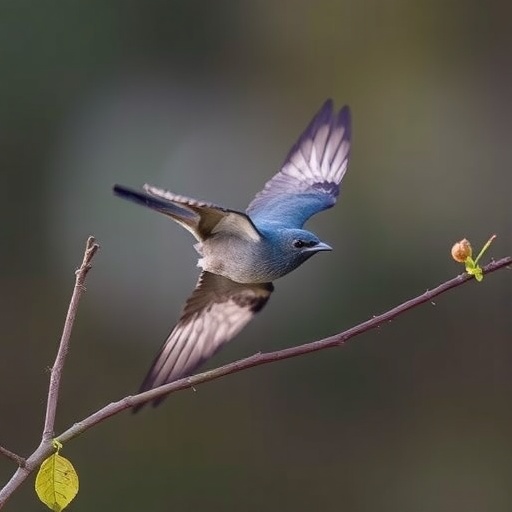A groundbreaking new study from Lund University in Sweden has shed light on the intricate biomechanics of migratory bird flight, revealing that these avian travelers achieve peak energy efficiency not at high or low speeds as previously assumed, but rather at a medium, carefully optimized pace. This discovery overturns long-held assumptions in avian physiology and offers profound insights into the evolutionary adaptations that enable small birds like the thrush nightingale to undertake their epic transcontinental journeys.
Migratory birds endure some of the most physically demanding feats in the animal kingdom, spending countless hours aloft as they traverse continents. Until now, aerodynamic models and metabolic theories largely posited that birds maintain a consistent efficiency in converting metabolic energy into mechanical power across a range of flight speeds. However, the research team at Lund University, utilizing precise wind tunnel experiments with thrush nightingales (Luscinia luscinia), has demonstrated that this efficiency is highly variable and strongly dependent on the velocity of flight.
The experiments involved placing thrush nightingales in a controlled wind tunnel environment, allowing the researchers to measure real-time metabolic rates alongside wingbeat kinematics and aerodynamic output. Through this method, the team was able to delineate the relationship between flight speed and energy conversion efficiency with unprecedented precision. Principal investigator Pablo Macías Torres explains that the birds exhibited a pronounced peak in efficiency at an intermediate flight speed—approximately seven to eight meters per second. This is particularly noteworthy given that neither lower speeds, which demand greater time aloft, nor higher speeds, which increase aerodynamic drag and muscular exertion, were energetically optimal.
Previous estimations suggested that migratory birds convert roughly 23% of their metabolic energy into mechanical power to sustain flight. However, this new study reveals that the maximal conversion efficiency is closer to 15%, and crucially, this rate fluctuates according to flight speed. The implications are far-reaching, as they challenge existing metabolic models and call for recalibrated simulations that more accurately reflect the biomechanical realities of migration.
The discovery of an optimal mid-range efficiency speed has significant ecological and evolutionary importance. Migratory flight imposes extreme physiological stresses; optimizing energy expenditure at an intermediate speed likely represents a refined evolutionary response to the demands of long-distance travel. By conserving energy through efficient flight mechanics, thrush nightingales—and potentially other small migratory species—can maximize their endurance and survival during their arduous journeys across continents.
Understanding these dynamics also opens new avenues for examining the neuromuscular and respiratory adaptations that facilitate such precision in flight performance. Precise modulation of wingbeat frequency, muscle fiber recruitment, and metabolic pathways likely underpin the birds’ ability to sustain this energetically favorable speed. Further research into these physiological facets could illuminate fundamental principles of muscle efficiency and bioenergetics applicable across species.
Moreover, this refined understanding offers transformative potential for bio-inspired engineering. The flight patterns and energy optimization strategies of migratory birds like the thrush nightingale could inform the development of more efficient unmanned aerial vehicles (UAVs) and drones, especially those designed for endurance and long-range missions. Insights into the mechanics of intermediate speed efficiency could lead to advances in wing design, power management, and aerodynamic control systems.
This breakthrough also provides vital context for conservation biology. Migratory birds face increasing challenges from habitat loss, climate change, and anthropogenic disturbances. A clearer comprehension of their energetic constraints and optimal flight mechanics can guide habitat management and the timing of conservation interventions to coincide with critical phases in migration when energy efficiency is paramount.
By integrating precise metabolic measurements with aerodynamic data, the Lund University research navigates past theoretical assumptions into a realm of empirical clarity. This positions scientists to better predict how migratory birds might respond to environmental shifts, such as changing wind patterns or temperature fluctuations, which could alter their energy budgets and migratory success.
The research is not only a significant leap toward demystifying avian flight energetics but also underscores the sophistication of natural selection in sculpting physiological traits for optimal function. As Pablo Macías Torres encapsulates, “Understanding birds’ flight efficiency helps us to assess the remarkable physiological adaptations that make it possible for birds to conquer the air and complete extraordinary long-distance flights, such as the nightingales’ impressive flight south.”
These findings contribute to the growing body of knowledge that posits biological efficiency as a dynamic, context-dependent parameter rather than a fixed characteristic. They emphasize the necessity for nuanced models that accommodate variability in behavior and performance, thereby enriching the precision of ecological and evolutionary predictions.
The study’s innovative approach involving wind tunnel testing of live birds marks a methodological milestone, offering a replicable model for future investigations into flight mechanics across migratory species. Such work promises to enhance our holistic understanding of migration physiology and could contribute substantially to preserving biodiversity amidst rapidly changing global conditions.
In sum, this research reframes the narrative surrounding migratory bird flight, highlighting a delicate balance of speed and energy efficiency achieved at intermediate velocities. This nuanced insight not only advances avian biology but also illustrates the elegance with which living organisms navigate the physical challenges posed by their environment, inspiring both scientific inquiry and technological innovation.
Subject of Research: Flight energy conversion efficiency in migratory birds
Article Title: Energy conversion efficiency peaks at intermediate flight speed in a migratory songbird
News Publication Date: 4-Jun-2025
Web References:
10.1016/j.cub.2025.05.025
Image Credits: Animal Flight Lab, Lund University
Keywords: Migratory birds, flight efficiency, thrush nightingale, wind tunnel experiments, metabolic energy conversion, biomechanics, avian physiology, flight speed optimization, migration energetics, bioenergetics, physiological adaptation, ornithology




